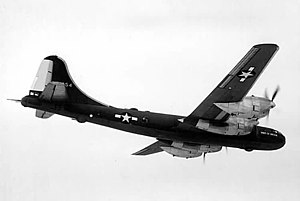Boeing XB-39 Superfortress
| XB-39 Superfortress | |
|---|---|
 |
|
| Boeing XB-39 serial number: 41-36954 | |
| Role | Heavy bomber |
| Manufacturer | Boeing |
| First flight | 1944 |
| Primary user | United States Army Air Forces |
| Produced | 1944 |
| Number built | 1 |
| Developed from | Boeing B-29 Superfortress |
The Boeing XB-39 Superfortress was a United States prototype bomber aircraft, a single example of the B-29 Superfortress converted to fly with alternative powerplants. It was intended to demonstrate that the B-29 could still be put into service even if the first choice of engine, the air-cooled Wright R-3350 radial engine, ran into development or production difficulties.
Starting life as the first YB-29 delivered to the United States Army Air Forces, it was sent in November 1943 to the Fisher Body Aircraft Development Section of General Motors to be converted to use Allison V-3420-17 liquid-cooled W24 (twin-V12, common crankcase) inline engines. Fisher was chosen for the modification as it was familiar with the engine, as it was to power the P-75 Eagle that they were then developing. Testing on it began in early 1944.
Further development of the engine and the aircraft was delayed by a series of changes in the planned turbosuperchargers, as the originally specified GE Type CM-2 two-stage turbosupercharger became unavailable due to demands on GE's production of its other turbosuperchargers. Other turbosuperchargers were considered, but the end result was that the first flights of the B-39 had to be made without any turbosuperchargers at all.
In addition, in early 1944, due to a sudden realization from the U.S. Army Air Forces that it required a long range air superiority fighter, Fisher was directed to focus on its other major project, the P-75 Eagle. In June 1944, Fisher received a contract for 2,500 P-75s. However, in October 1944, for a variety of reasons, the P-75 was canceled.
Fisher finally focused again on the B-39. The first flight of the B-39 was made on 9 December 1944 at Cleveland, Ohio. The initial flight tests of the B-39, without turbosuperchargers installed, were impressive. However, the B-39 program was by now seriously delayed, and the flawed R-3350 B-29s had already been rushed into combat in June 1944.
...
Wikipedia
